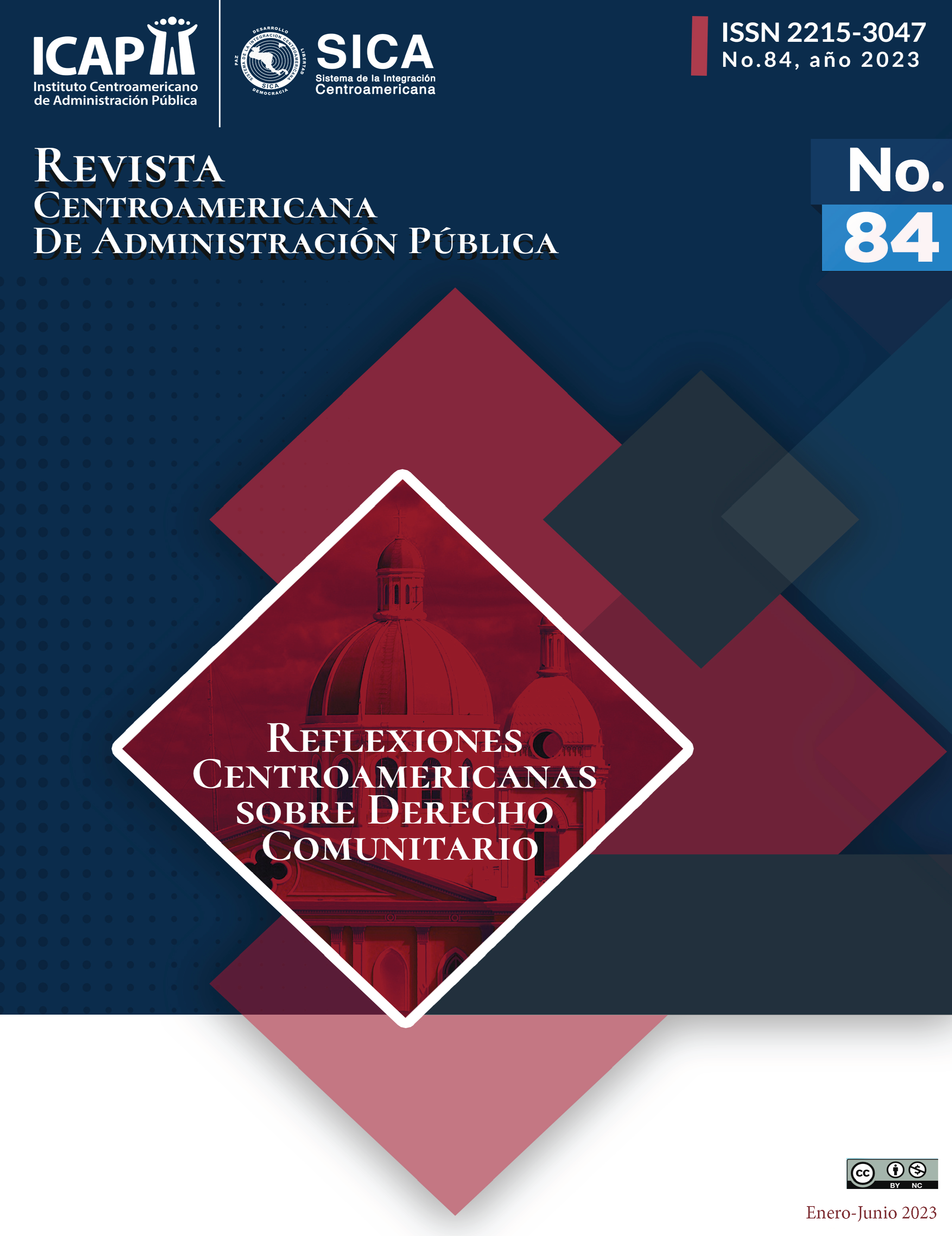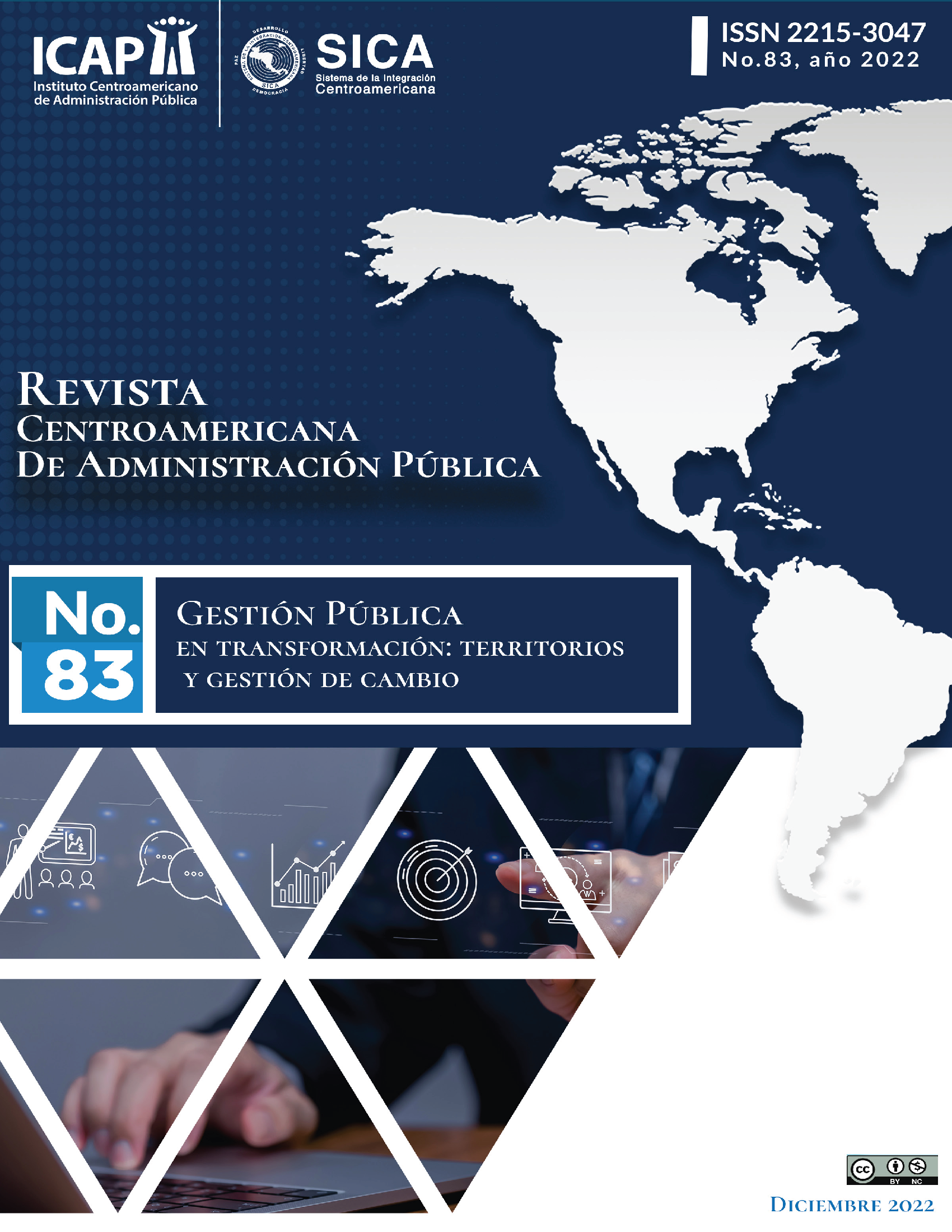Archivos - Página 2
-

Reflexiones Centroamericanas sobre Derecho Comunitario
Núm. 84 (2023)Para alcanzar la justicia hacen falta tres elementos: educación legal y cívica para
todos, instituciones sólidas de derechos y respeto a los preceptos legales o
constitucionales. Así, las dos últimas constituyen lo que los abogados llamamos
Estado de Derecho.Es muy oportuno la edición de esta revista en la que se conjugan dos instituciones
--el Instituto Centroamericano de Administración Pública de Centroamérica y
Panamá (ICAP), y la Corte Centroamericana de Justicia (CCJ). Ambas instituciones
son dos pequeños pilares dentro de una gran organización: el Sistema de la
Integración Centroamericana (SICA), que queremos hacer crecer y fortificarse
para que haya más sustento en la integración de nuestros países, se cohesionen
y fortalezcan nuestras naciones y los gobiernos del área que las conforman. -

Gestión pública en transformación: territorios y gestión de cambios
Núm. 83 (2022)Transformar y adaptar la gestión pública a las nuevas necesidades sociales debe ser un compromiso renovado de la administración. El cambio y la innovación son parte de la humanidad misma, pero hoy en día los entornos digitales, la inmediatez de la comunicación y los diferentes frentes de riesgos, requiere de lo público, una mejor gestión de datos, información y la generación de entornos resolutivos que apunten a mayores niveles de desarrollo.
Lo cierto es que esta es una lectura que es difícil de poner en marcha, pues, aunque hay un esfuerzo consciente desde la administración, las ocupaciones de lo diario terminan dominando la agenda dejando de lado el entorno más amplio, haciendo más complicado que pueda operar desde la estrategia, sumado a que la gestión y adaptación a una dinámica dominada por lo digital, genera una convergencia entre las prácticas del ayer y las nuevas costumbres del hoy, donde se pueden acentuar desigualdades y brechas de conocimiento.
El discurso del cambio está presente más que nunca en el ideario compartido y también en la gestión, sin embargo, hay una amplia cantidad de intereses, incertidumbres y límites, y en el contexto de la postpandemia ha tomado relevancia la capacidad de las instituciones por generar confianza, tanto desde lo estratégico de dirección, administración, pero también por la alineación de las expectativas desde los territorios y las poblaciones vulnerables.
En ese contexto, la edición número 83 de la Revista Centroamericana de Administración Pública, propone una revisión de los cambios y la adaptación de lo público, concentrándose en tres temáticas relevantes; la territorialidad, la migración y la educación. Revisando desde la investigación y los casos aportes y transformaciones que han sido puestas en marcha y que ayudan a entender mejor los fenómenos y a aportar desde nuevas soluciones.
-

Transformación y gerencia de sistemas de salud: aportes de investigación para la generación de valor público
Núm. 82 (2022)Para este servidor, en su calidad de coordinador del Centro en Sistemas de Salud y Seguridad Social (CSS-SS) y del Programa en Gerencia de la Salud del ICAP, y como parte de esa responsabilidad general, coordinador de la Maestría en Gerencia de la Salud, es un privilegio introducir con el presente editorial, la versión número 82 de la Revista Centroamericana de Administración Pública.
Este número se dedica específicamente a temas relacionados con la gerencia pública de la salud y la seguridad social, a partir de la publicación de un conjunto de artículos que se originan en los trabajos finales de graduación aprobados como parte del proceso de formación de un grupo de estudiantes, quienes hoy ya ejercen como profesionales con grado de Magister Scientae en Gerencia de la Salud del ICAP.
Como se podrá observar los temas se enmarcan en dos grandes líneas; la primera relacionada con la mejora de la gerencia de los servicios de salud y la segunda vinculada con la mejora de la protección social en Costa Rica, no obstante, todos los temas tratados tienen un carácter universal, por lo que sirven de insumo relevante para todos los países de la región del SICA.
En lo relacionado con la gerencia pública de la salud el punto de partida es la premisa de que gerencia implica tomar decisiones y, por lo tanto, el desafío es lograr que esas decisiones sean correctas e inteligentes. Para lograrlo se requiere la aplicación de racionalidades, de la capacidad de pensar, evaluar, entender y actuar de acuerdo con ciertos principios de mejora y consistencia, para satisfacer algún objetivo o finalidad. La racionalidad es una virtud innata del ser humano que le permite discernir en una situación dada.
Las racionalidades aplicables son aquellas que consideran relevantes las buenas decisiones al interior de las organizaciones: i) racionalidad política que orienta el rumbo institucional, ii) la racionalidad técnica, relacionada con “el contenido” del quehacer institucional, iii) racionalidad administrativa vinculada con el necesario soporte requerido en cuanto a los recursos, los métodos y el proceso de toma de decisiones institucional, iv) la racionalidad legal asociada con el marco legal y jurídico que condiciona la toma de decisiones y v) la racionalidad ética relacionada con los valores que dan sustento al proceso de toma de decisiones.
Se trata de comprender como el proceso de toma de decisiones debe armonizar las cinco racionalidades mencionadas, nunca ponerlas en contradicción, una responsabilidad indelegable y no negociable que debe asumir el gerente al tomar decisiones.
Ese concepto de gerencia implica entonces una simbiosis entre la conducción (dirección) y administración; la conducción tiene implicaciones éticas en la función o sea se relaciona con hacer lo correcto, para lo que es necesario el conocimiento y aplicación de destrezas gerenciales esenciales: creatividad, innovación, liderazgo, motivación y negociación, entre otras. Por otra parte, la administración implica el conocimiento necesario para lograr hacerlo correctamente, es decir, las capacidades para definir normas y cumplir con las funciones gerenciales de planificación, de organización, de atraer y conservar personal idóneo, de delegación, de supervisión, de medición y generación de información útil para la toma de decisiones.
En ese contexto, es que tres de los temas que se tratan en el presente número de la Revista, se relacionan con asuntos vinculados con la buena gerencia de los servicios de salud. El primer artículo por Diana Salas incursiona en la aplicación de la metodología de calidad Lean a las salas de operaciones, en este caso, de un hospital nacional de máxima complejidad en Costa Rica, el Hospital San Juan de Dios. La metodología permite mejorar la calidad del servicio, la mejora en la utilización de los recursos, la disminución de los tiempos de espera para acceder al servicio y la disminución de los costos. Es un ejemplo de aplicación a lo público de una herramienta de gestión que puede ser de gran utilidad para beneficio de la población.
La estrategia propuesta por Stephen Guinee de unidades de corta estancia para los servicios hospitalarios, es de gran utilidad para mejorar la gerencia de dichos servicios, la optimización del uso de los recursos y la disminución de sus costos. Las unidades de corta estancia aportan a la estandarización de procesos, lo que permite la disminución de la estancia hospitalaria y el aumento del giro cama que generan como resultado, la mejora de la eficiencia de los servicios, comprendiendo que la cama es el recurso hospitalario por excelencia, ya que la planificación del establecimiento gira a su alrededor.
Por otra parte, la propuesta de clasificación de Áreas de Salud que realizan Juan Carlos Obando, Alberth Méndez y Andrés Cairol, aporta de manera significativa a la correcta asignación de los recursos a nivel de las redes de servicios de salud, tomando como referencia criterios de cobertura poblacional, capacidad instalada, producción, horarios de atención y en general, complejidad de los servicios que tienen como responsabilidad.
De frente a estos tres temas vinculados a la buena gerencia, específicamente, y en el contexto del marco conceptual enunciado inicialmente, a la buena administración de los servicios de salud, se presentan tres artículos vinculados al mejoramiento de la protección social en Costa Rica, comprendiendo que aportan a definir su rumbo en razón de las necesidades poblacionales y son de utilidad para la región del SICA en general.
El primero de estos es el análisis que realizan Angela Morales y Angie Parra para mejorar el proceso de otorgamiento de pensiones del régimen no contributivo, que busca no solo un aporte desde la eficiencia institucional, sino también al acceso de una población en desventaja social a una pensión básica. El estudio demuestra, no solo las debilidades del proceso de otorgamiento sino la deficiencia de algunos criterios para hacerlo, afectando la calidad de vida de muchas personas. Las autoras realizan una propuesta que mejora de forma integral todo este proceso.
Además, el estudio de factibilidad que realizan Kenny Rojas y Jorge Peñaranda, para aumentar la cobertura de los análisis genómicos en personas con sospecha heredofamiliar de cáncer de mama y cáncer colorrectal plantea uno de los desafíos de la medicina contemporánea y del futuro: la atención personalizada sobre la base de las necesidades específicas de las personas. En Costa Rica, durante el año 2020, solo el 24% de los casos nuevos que padecieron este tipo de cáncer con sospecha heredofamiliar, tuvieron acceso al análisis, derivado de la escasez de recursos existentes.
Finalmente, Eugenia Mata y Horacio Chamizo presentan un artículo que vincula el correcto abordaje del problema del consumo de drogas en Costa Rica y la construcción de la política pública en este campo que parte de la premisa de que el consumo de drogas es un problema de salud pública, y debe ser trabajado como tal, un aporte de gran valor, no solo para el país, sino para la región del SICA.
De forma complementaria a los artículos originados en trabajos finales de graduación, la revista presenta dos documentos que tratan temas generales vinculados a la realidad social y económica de Costa Rica y la región del SICA; Jean Paul Vargas incursiona en el tema del parlamento y la innovación institucional, un documento de carácter conceptual y reflexivo, que asume como tarea incursionar en una aproximación de los enfoques de modernización parlamentaria, vistos desde la importancia del cambio institucional y los equilibrios inducidos. El documento inicia la discusión tomando una posición conceptual sobre el Parlamento como institución, seguido de comprender la gobernanza parlamentaria y la capacidad institucional, cuya reflexión acumulada permite abordar los diversos enfoques en materia de modernización parlamentaria.
Finalmente, Ángel Abelino Ortega, incursiona en el tema de la pobreza y pobreza extrema en Costa Rica, presentándola como una deuda histórica del país, a pesar de los esfuerzos realizados en el campo de lo social por diversos gobiernos.
El autor considera que sin pretender una respuesta definitiva, que la situación de pobreza podría tener relación directa con el tipo de política social impulsada por los gobiernos de los últimos 40 años, la obsolescencia de la gestión de la institucionalidad del sector social, la imposibilidad de articular una estrategia respetando los espacios de trabajo de cada institución y, el cortoplacismo de los procesos de planificación, por lo que es necesaria una revisión profunda del modelo trabajado y realizar los ajustes pertinentes para cambiar lo necesario.
En síntesis, el presente número de la Revista Centroamericana de Administración Pública es un aporte significativo a la gerencia pública de la salud que toma como referencia la realidad costarricense, pero que sin duda, aporta a la realidad de todos los países del SICA.
Mauricio Vargas Fuentes
Mayo, 2022. -

¿Cómo el COVID cambió la Gestión Pública? Reflexiones sobre la transformación, la resiliencia y los retos de lo público para construir un mejor futuro regional
Núm. 81 (2021)“¿Cómo el COVID cambió la Gestión Pública? Reflexiones sobre la transformación, la resiliencia y los retos de lo público para construir un mejor futuro regional”
En medio de la transformación obligada por la crisis de salud global, todos los espacios de la vida se vieron modificados, la falta de cercanía física supuso también una revalorización de los espacios comunes, oportunidades para un acercamiento distinto, pero también plural, un llamado a construir entre muchos que ahora mismo sabemos es indispensable.
Hacer gestión de lo público en contextos de incertidumbre es complejo y requiere al menos de la articulación entre instituciones y actores (ciudadanos, empresas privadas, organizaciones no gubernamentales), buscando ser capaces de acoplar los diversos andamiajes prácticos y de pensamiento para ponerlos al servicio del bien común.
La coyuntura cambió lo personal, lo común y también lo institucional, obligando a estructuras robustas a transformase a lo digital en días, todos los campos se vieron permeados, pero especialmente interesante fue ver como los modelos de gestión y comunicación, mutados a la exclusiva virtualidad terminaron por dominar los espacios de toma de decisión y generación de políticas, lo público, se transformó por un momento en un aparato virtual o al menos virtualizado, una realidad que parecía lejana hace 18 meses, pero que se convirtió en normalidad, sin embargo, ¿cuánto nos cambió este espacio?, ¿verdaderamente aporta a lo público? o ¿es mejor regresar a lo físico?.
Las estrategias desarrolladas antes de la crisis, si es que existían, obviamente no fueron eficientes ni suficientes, porque está claro que no se podía prever el alcance del reto que trajo consigo la crisis de salud ocasionada por la COVID-19. Los modelos de gestión anteriores no estaban preparados para la ruptura, pero aun así generaron respuestas a la coyuntura, dando pistas de que son capaces de adaptarse al entorno y no solo vivir anclados a los procesos tradicionales.
Lo que al menos se ha puesto sobre la mesa es un discurso sobre el cambio -y el aprovechamiento de este- que está presente más que nunca en el ideario compartido, la crisis de salud se convirtió también un espacio de oportunidades y desde lo público, en una pequeña ventana que puede suponer la fuerza positiva para proponer nuevas rutinas, rompiendo paradigmas y construyendo respuestas alternativas a las problemáticas comunes; pues la aplicación de herramientas tecnológicas, la utilización de datos y metadatos para la toma de decisiones y el interés del recurso humano por agregar conocimientos fueron parte también del manejo de la crisis.
Por eso, es que esta edición de la Revista Centroamericana de Administración Pública busca explorar los espacios que este contexto de cambio ha sido capaz de permear en el marco de la generación y evolución de la gestión pública de la región.
Teniendo en cuenta que para transformarnos verdaderamente es necesario entender lo propio y empezar a construir soluciones a partir de esas particularidades, priorizando la rigurosidad ética y técnica y abrazando la innovación en todos los niveles; político, institucional, técnico para que en efecto sea capaz de contribuir a la generación de la confianza y la legitimidad necesarias para construir una percepción de satisfacción social en un futuro no ideal, si no posible.
Entendiendo que los enfoques de gestión posteriores a la crisis de salud deben tener como pilar la búsqueda del bienestar social con un amplio componente de equilibrio ambiental, gestión de datos y responsabilidad futura, la gestión de hoy deben focalizarse en optimizar los sistemas actuales para promover transformaciones y el cambio progresivo, incluyendo a la mayor cantidad posible de sectores.
Esta edición número 81 de la Revista Centroamericana de Administración Pública, reconoce ser un ejercicio deliberativo, descriptivo y funcional, que parte de situaciones propias de la realidad centroamericana, buscando entender los desafíos del ejercicio del gobierno en la postpandemia, a la vez que acercando la mirada a los nuevos amaneceres que ofrece el contexto actual, anclada en la necesidad de evolucionar el entendimiento de lo público en la región, a partir de la generación y transmisión de conocimiento y del pensamiento crítico y disruptivo.
Esta revista contiene dos grandes secciones; artículo y documentos, en la primera parte se incluyen trabajos desarrollados por investigadores e investigadoras de la región que partiendo de casos específicos han puntualizado en conceptos sobre el desarrollo, la innovación y los retos de la región en la post pandemia.
-

Reflexiones sobre Asia-Pacífico: Lecciones aprendidas y oportunidades en entornos de transformación global
Núm. 80 (2021)"El siglo de Oriente: La importancia de Asia en la geopolítica económica y sanitaria".
Comprender la coyuntura requiere conocer el contexto; para entender la transformación económica y social que el mundo afronta actualmente como producto no sólo de la crisis sanitaria, sino también de los ajustes económicos estructurales a nivel macro y micro hay que reconocer que el cambio forma parte del sistema, y que los retos y rupturas espontáneas también forman parte de ese entorno.
En medio de una crisis global, es importante hacer un balance de los procesos que han sido más o menos eficientes según cada circunstancia y aprender de aquellos que han ofrecido soluciones eficaces, reconociendo las buenas prácticas.
En el contexto internacional, el continente asiático se ha convertido en un actor clave en la dinámica geopolítica, determinando decisiones y políticas a nivel global.
Tras el establecimiento de China como segunda economía mundial en 2010, así como el rápido crecimiento de las economías del sudeste asiático, el sistema internacional ha reconocido a Asia como el nuevo centro de gravedad económico, político y social. El periodo post-pandémico se articulará en función de las relaciones estructurales presentes en la región asiática, poniendo fin a la configuración histórica de las relaciones internacionales desde la perspectiva occidental. Es por ello que la situación de los estados asiáticos se convierte en el motor de la investigación, instrumentalizando la óptica analítica nacional y regional para el análisis internacional.
El poder de la región oriental se articula en el liderazgo de sus estados en materia económica, social y sanitaria. Desde la década de 1990, si analizamos las tasas de crecimiento de casi todas las economías del continente, éstas se han mantenido en las categorías de "sostenidas" o "muy altas". La crisis económica mundial de 2008-2009, que afectó exhaustivamente a las economías occidentales, no generó los mismos desajustes estructurales en Asia, demostrando la capacidad de adaptación a las circunstancias económicas, su preocupación por los mercados internos y externos y el papel de este espacio geográfico como líder en el proceso de recuperación económica mundial.
Estos avances se tradujeron en la construcción de una percepción de preocupación estructural de Occidente, concretamente ante el crecimiento de India y China; y su papel en la geopolítica mundial. En términos de influencia económica internacional, Asia se convierte en el eje de interés en términos de Inversión Extranjera Directa (IED), política comercial y consumo de energía y otras materias primas fundamentales.
En el actual contexto internacional, la importancia de Asia se ha visto reflejada en su respuesta institucional a las consecuencias tanto económicas como sanitarias de la pandemia. En el contexto de Covid-19, Asia ha surgido como el líder más eficaz en la gestión de las respuestas al virus. Principalmente China, Corea del Sur, Taiwán y Hong Kong, que en las fases iniciales de la crisis consiguieron reducir drásticamente las tasas de infección y las muertes en sus territorios, gestionando responsablemente la pandemia. Además, tomando como referencia el vínculo entre economía y salud, China se ha convertido en la única gran economía que creció, aunque mínimamente, en 2020, reflejando el declive de la hegemonía estadounidense y el deterioro del papel de Occidente como actor principal en la dinámica internacional.
Otro elemento que ha puesto de relieve el papel de Asia en el juego geopolítico ha sido el nivel de integración económica y comercial de los países. En concreto, destacan la Asociación de Naciones del Sudeste Asiático (ASEAN) y la Asociación Económica Integral Regional (RCEP) en 2020. Esta integración ha reforzado los lazos económicos y de seguridad de los países, estructurando la región como un bloque comercialmente cohesionado. La construcción de la "Nueva Ruta de la Seda" ha sido un movimiento estratégico de China, que ha aprovechado los efectos interconectados del proceso de globalización. El objetivo del gigantesco proyecto económico es conectar a China con el mundo, y así establecerse como un actor importante en el sistema internacional, a través de una serie de proyectos de infraestructura. Por otra parte, el crecimiento económico estable de los Estados asiáticos contribuye a reducir los descensos del ciclo económico y las crisis financieras repentinas, proporcionando un cierto grado de estabilidad al sistema financiero internacional.
Además, comienzan a operar en espacios más allá de la coyuntura, el Banco Central de China ha comenzado a probar una versión digital del yuan, impulsando la digitalización del sistema económico, lo que representaría un impacto significativo en la geopolítica mundial, colocando al continente asiático como el punto de referencia digital internacional, así como el establecimiento de un desafío a la supremacía del dólar como medio de intercambio comercial (y específicamente a la hegemonía estadounidense). El fintech, comúnmente conocido como tecnología financiera, se ha convertido en un punto de interés para los aparatos estatales asiáticos, no sólo en China sino también en países del sudeste asiático como Singapur, con el objetivo de preservar su tipología como centro financiero global.
En el ámbito de la salud, el éxito de la gestión ha surgido como resultado del sistema de respuesta estatal. En esta situación de crisis, se ha gestionado la táctica institucional de "encontrar, aislar, evaluar y tratar cada caso". Como resultado de su poder estatal, el aparato ha logrado la aplicación de pruebas agresivas, rastreo y posterior cuarentena. Sin embargo, específicamente en el caso de Asia, la ventaja comparativa se ha articulado en el uso de las Tecnologías de la Información y la Comunicación (TIC) como herramientas estratégicas para el seguimiento y control de los casos. Por ejemplo, en China, Japón y Corea, el uso de las TIC como herramientas estratégicas para el seguimiento y control de los casos ha supuesto una ventaja comparativa.
En el Sur, se crearon o adaptaron aplicaciones móviles controladas por el gobierno para facilitar el seguimiento eficaz de los casos positivos de Covid-19.
Otra lección aprendida a nivel internacional de la gestión de la crisis sanitaria en Asia fue el proceso estructurado de recopilación e interpretación de datos y la investigación destinada a comprender la dinámica y el comportamiento del virus. Ante la emergencia en los territorios nacionales, los estados asiáticos buscaron establecer alianzas con centros de investigación a través de la tecnología. Durante la implementación de dichas alianzas, se pone a prueba la importancia de Asia como centro de investigación y tecnologías, destacando la importancia geopolítica en materia de salud. Como otro ejemplo de la fuerza de la región, en Taiwán y Japón se utilizó un sistema de rastreo, apoyado por la cartografía de los contagios y los vínculos epidemiológicos. Además, Hong Kong utilizó un sistema de control basado en pulseras electrónicas, que se entregaron a las personas que llegaban del extranjero.
La relevancia de Asia se ha estructurado en conjunción con diversos acontecimientos socio-históricos de la región, ejemplificando el papel de los estados en el juego internacional. Sin embargo, es importante mencionar la influencia de los conflictos asiáticos en las relaciones internacionales, impulsando la necesidad de aumentar la atención de la opinión pública internacional, en temas como la situación histórica de China con los territorios de Hong Kong y Taiwán. Como consecuencia del aumento de la importancia geopolítica del continente, los espacios de discusión y negociación internacional deben construirse prestando atención a la situación, los avances y los logros de Asia.
Las principales cuestiones y problemas internacionales de los últimos años se han construido desde la perspectiva de la creciente influencia positiva del continente asiático, concretamente de China y de los famosos "tigres asiáticos". También es fundamental entender la buena gestión de la transformación estructural del sistema internacional de los Estados asiáticos, adaptándose desde una perspectiva de crecimiento económico sostenido y uso gubernamental de las tecnologías en el marco de los procesos de la economía digital y en una sociedad interconectada, sin embargo, esto no quita que también existan importantes problemas en la región, tanto a nivel interno como entre países, por ejemplo, China tiene algunos frentes de conflicto abiertos; Hong Kong, Taiwán, los conflictos territoriales por la construcción de islas artificiales, la guerra comercial con Estados Unidos y otra serie de conflictos que, si no se gestionan bien, pueden aumentar la inestabilidad.
Asimismo, el aumento de las reivindicaciones sociales en países como Tailandia, el golpe de Estado en Myanmar, las críticas a los regímenes políticos de Filipinas y Singapur por sus posibles violaciones de los derechos humanos, los constantes escándalos de corrupción en Corea del Sur, son problemas internos que sugieren que no hay un modelo de receta para el desarrollo y aunque hay importantes avances económicos, en Asia y Asia Pacífico hay importantes retos que deben ser abordados en beneficio de la sociedad.
Aún así, el continente se convierte en el punto de referencia para el aprendizaje de otros países en un sinfín de áreas, un ejemplo a seguir en términos económicos y de salud, sin duda, el siglo XXI es el de Oriente.
Esta edición de la Revista Centroamericana de Administración Pública ofrece una serie de reflexiones y aprendizajes sobre la región Asia-Pacífico en el actual contexto internacional, caracterizado por la constante transformación de las estructuras sociopolíticas y económicas. La importancia geopolítica de la región asiática ha permeado las estructuras mentales de cómo pensar las relaciones internacionales entre los Estados, motivando la producción de conocimiento que estructura el análisis nacional y regional de los Estados asiáticos, así como su influencia a nivel internacional en la toma de decisiones multilaterales.









